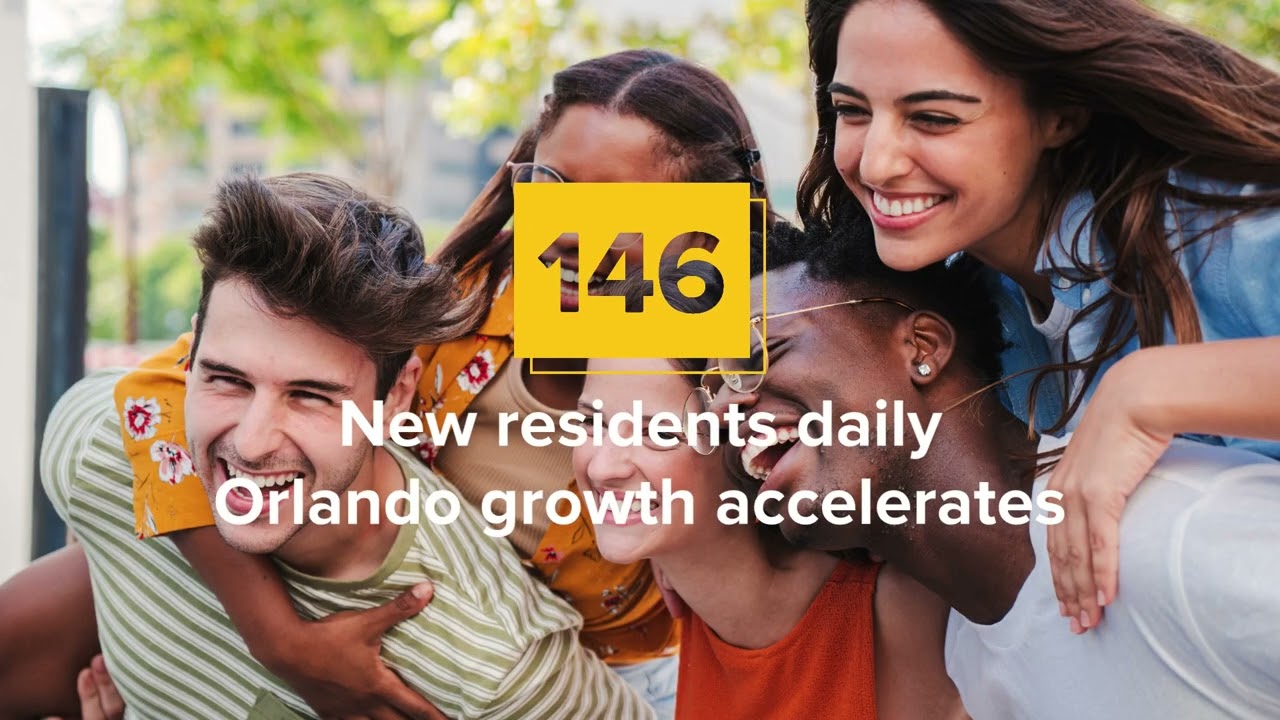I’ve lived in Orlando for over a decade, and the growth I see in our city never fails to amaze me. The numbers back this up – Orlando just hit 326,988 residents in 2023, adding nearly 20,000 people since 2020. That’s like filling the Amway Center at maximum capacity.
The bigger picture is even more striking. The Orlando metro area now has 2.8 million residents spread across Orange, Seminole, Osceola, and Lake counties. We’ve grown by 160,388 people since 2020 – that’s about 146 new residents every day for three years straight. Looking at the data from the U.S. Census Bureau, our metro grew 6% from 2020 to 2023, outpacing many other major U.S. cities.
The growth isn’t slowing down either. From young families moving to Winter Garden to retirees choosing Lake County, each part of greater Orlando tells its own growth story. Take Osceola County – it grew 13% in just three years, making it our fastest-growing county. Or look at the small town of Oakland in Orange County, which saw its population jump by 53.6% since 2020.
City of Orlando demographics
The City of Orlando’s population tells a story of steady growth and diversity. While we reached 326,988 residents in 2023, what’s more interesting is how our population has changed over time. The city grew 29.1% from 2010 to 2020, adding about 69,273 residents. Then from 2020 to 2023, we added another 19,415 people – a 6.3% increase in just three years.
Let’s look at our city’s current demographic makeup. The data shows Orlando has a balanced age distribution, with nearly half our population in their prime working years. Our educational attainment levels show we’re a city of learners and professionals – 41.2% of Orlando residents hold a college degree.
Age distribution in orlando MSA (2023)
| Age Group | Percentage | Number of Residents* |
|---|---|---|
| 25-54 years | 48.0% | 1,360,207 |
| 0-17 years | 20.6% | 583,755 |
| 65 and over | 11.8% | 334,384 |
| 55-64 years | 10.9% | 308,880 |
| 18-24 years | 8.7% | 246,538 |
| Total | 100% | 2,833,764 |
*Calculated based on total MSA population
Looking deeper at these numbers, we see three key trends:
- Our working-age population (25-54) makes up the largest group at 48%. This matches our job market growth, with the Orlando Economic Partnership reporting strong gains in professional services and healthcare sectors.
- The youth segment (0-17) represents over one-fifth of our population at 20.6%. This large presence of families with children drives demand for education – our region awarded 59,816 degrees in 2023 across all educational levels.
- The retirement-age population (65 and over) sits at 11.8%, lower than many might expect for Florida. This balanced age distribution suggests Orlando attracts residents across all life stages, not just retirees.
Educational attainment (population 25+)
| Education Level | Percentage |
|---|---|
| Bachelor’s degree | 26.4% |
| Graduate degree | 14.8% |
| Associate’s degree | 11.9% |
| Some college, no degree | 17.8% |
| High school graduate | 21.0% |
| No high school diploma | 8.1% |
These numbers paint a picture of Orlando as a young, educated city. The median age is 35.3 years, and more than 4 in 10 adults have a college degree. This mix of youth and education creates a strong foundation for our city’s continued growth and economic development.
Orlando metropolitan area growth
The Orlando metro area’s growth story is told through numbers that keep climbing. From 2020 to 2023, our region added enough people to fill up Disney’s Magic Kingdom three times over. That’s 160,388 new residents who now call the Orlando MSA home.
Each county in our metro shows distinct growth patterns over the past 13 years. Let’s break down the numbers:
Orlando MSA population crowth by County (2010-2023)
| County | 2010 Population | 2020 Population | 2023 Population | Growth 2020-2023 | Growth 2010-2020 |
|---|---|---|---|---|---|
| Orange | 1,145,956 | 1,429,908 | 1,492,951 | 4.4% | 24.8% |
| Seminole | 422,718 | 470,856 | 486,839 | 3.4% | 11.4% |
| Osceola | 268,685 | 388,656 | 439,225 | 13.0% | 44.7% |
| Lake | 297,052 | 383,956 | 414,749 | 8.0% | 29.3% |
| Total MSA | 2,134,411 | 2,673,376 | 2,833,764 | 6.0% | 25.3% |
Looking at these numbers, Osceola County stands out as our growth champion. It saw the highest percentage increase in the last three years at 13%, adding over 50,000 new residents. Lake County follows with an 8% growth rate since 2020.
Orange County, while showing a more modest 4.4% growth rate since 2020, still added the most people in raw numbers – about 63,000 new residents. This makes sense since Orange County holds the largest share of our metro population.
Seminole County grew at the steadiest pace, maintaining consistent growth of 3.4% from 2020 to 2023. This adds to its stable 11.4% growth from the previous decade.
County-by-county analysis
When you zoom in on each county in the Orlando MSA, you’ll find unique growth patterns that tell different parts of our region’s story. Let’s look at the detailed numbers for each county and its major cities.
Orange County cities population (2023)
| City | Population | Growth from 2020 |
|---|---|---|
| Orlando | 326,988 | 6.3% |
| Apopka | 58,293 | 6.2% |
| Winter Garden | 50,800 | 8.2% |
| Ocoee | 49,711 | 5.1% |
| Winter Park | 30,706 | 3.1% |
| Maitland | 19,964 | 2.2% |
| Unincorporated | 935,756 | 3.4% |
Seminole County cities population (2023)
| City | Population | Growth from 2020 |
|---|---|---|
| Sanford | 64,508 | 5.7% |
| Altamonte Springs | 47,420 | 2.6% |
| Oviedo | 40,261 | 0.5% |
| Winter Springs | 39,097 | 2.0% |
| Casselberry | 30,061 | 4.4% |
| Lake Mary | 17,366 | 3.4% |
| Unincorporated | 231,718 | 3.2% |
Osceola County cities population (2023)
| City | Population | Growth from 2020 |
|---|---|---|
| Kissimmee | 82,714 | 4.4% |
| St. Cloud | 61,997 | 5.1% |
| Unincorporated | 294,514 | 17.6% |
Lake County cities population (2023)
| City | Population | Growth from 2020 |
|---|---|---|
| Clermont | 47,456 | 10.3% |
| Leesburg | 30,378 | 12.5% |
| Eustis | 23,918 | 3.1% |
| Groveland | 22,760 | 23.0% |
| Minneola | 18,064 | 30.5% |
| Mount Dora | 17,843 | 9.2% |
| Unincorporated | 190,418 | 3.9% |
Looking at these numbers, we see some interesting trends. In Orange County, Winter Garden is growing faster than Orlando proper. Sanford leads Seminole County’s growth, while Osceola’s unincorporated areas are expanding rapidly. Lake County shows the most varied growth rates, with smaller cities like Minneola and Groveland seeing dramatic population increases above 20%.
Fastest growing areas
The Orlando metro area’s growth isn’t just about our big cities. Some of our smallest towns are growing at the fastest rates. From 2020 to 2023, several cities in our region saw population booms that outpaced the metro average of 6%.
Top 10 fastest growing cities in Orlando MSA (2020-2023)
| City | County | 2020 Population | 2023 Population | Growth Rate | New Residents |
|---|---|---|---|---|---|
| Oakland | Orange | 3,516 | 5,402 | 53.6% | 1,886 |
| Minneola | Lake | 13,843 | 18,064 | 30.5% | 4,221 |
| Mascotte | Lake | 6,609 | 8,565 | 29.6% | 1,956 |
| Groveland | Lake | 18,505 | 22,760 | 23.0% | 4,255 |
| Leesburg | Lake | 27,000 | 30,378 | 12.5% | 3,378 |
| Clermont | Lake | 43,021 | 47,456 | 10.3% | 4,435 |
| Mount Dora | Lake | 16,341 | 17,843 | 9.2% | 1,502 |
| Winter Garden | Orange | 46,964 | 50,800 | 8.2% | 3,836 |
| Orlando | Orange | 307,573 | 326,988 | 6.3% | 19,415 |
| Apopka | Orange | 54,873 | 58,293 | 6.2% | 3,420 |
The numbers show Lake County as a growth hotspot, with four of its cities in the top five fastest-growing areas. Oakland in Orange County tops the list with a 53.6% population jump – adding 1,886 new residents to what was a town of just 3,516 people in 2020.
Lake County’s growth corridor along State Road 50 shows particularly strong numbers. Minneola, Mascotte, and Groveland form a chain of fast-growing communities, each adding thousands of new residents. Minneola grew by 4,221 people, while Groveland welcomed 4,255 new residents.
These growth patterns point to a trend of people choosing smaller communities within commuting distance of Orlando’s job centers. While big cities like Orlando and Apopka continue steady growth around 6%, these smaller cities are growing at rates four to eight times higher.
What the numbers tell us about Orlando’s future
Based on the data we’ve analyzed, here are the key takeaways about Orlando’s population trends:
Growth patterns are shifting
Small towns are growing faster than big cities. Oakland’s 53.6% growth and Minneola’s 30.5% increase show people are choosing suburban communities over urban centers. This could reshape our real estate market and local economies in the coming years.
Lake county is the new growth hub
The numbers point to Lake County as an emerging population center. Four of the five fastest-growing cities are in Lake County. With cities like Groveland and Leesburg showing double-digit growth, this western edge of our metro area is becoming a major player in Orlando’s expansion.
We’re getting younger
While Florida is known for retirees, Orlando tells a different story. With 48% of residents between 25-54 and only 11.8% over 65, we’re primarily a working-age metro. The median age of 35.3 years suggests we’ll continue attracting young professionals and families.
Uneven growth creates new challenges
Growth isn’t spread evenly. Osceola County grew 13% while Seminole County grew 3.4% since 2020. This uneven pattern means different parts of our metro area face different challenges – from school capacity in fast-growing areas to maintaining services in slower-growing communities.
Population growth outpaces housing
With 160,388 new residents since 2020 but housing inventory struggling to keep up, our population growth suggests continued pressure on housing availability and affordability. This trend particularly affects fast-growing areas like Oakland and Minneola.







